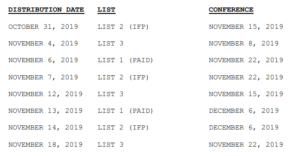The Supreme Court’s case distribution schedule identifies the dates on which petitions for writs of certiorari, along with corresponding briefs in opposition, amicus briefs and reply briefs, will be distributed (sent upstairs to chambers) to the justices. It also identifies the dates on which those petitions are scheduled to be considered (reviewed) by the justices at conference—a justices-only meeting which typically occurs on Fridays.
The Court uses “lists” to control the volume and flow of case review. Each conference is assigned cases in two categories of lists: “Paid” and “IFP”.
“Paid” lists include cases in which the petitioner pays the $300 filing fee under Rule 38(a); those cases have a docket number from 1 to 4999 following the prefix for the Term (e.g., No. 21-325). “IFP” lists include cases in which the petitioner has submitted the petition along with a motion for leave to proceed in forma pauperis under Rule 39; those cases have a docket number above 5000 following the prefix for the Term (e.g., No. 21-5474).
 Conference lists are then organized numerically, i.e., List 1 (Paid), List 2 (IFP), List 3 (Paid), List 4 (IFP), until sufficient casework has been assigned to a given Friday conference. The process starts over again for the next scheduled conference with “List 1 (Paid), List 2 (IFP).” You’ll notice that some consecutively numbered Lists (i.e., List 5) appear on the distribution schedule without Paid or IFP designations. These unlabeled lists consist of relisted cases—cases that the Court will review again after previously considering them at another conference. The schedule even includes planned Summer List (SL) distributions.
Conference lists are then organized numerically, i.e., List 1 (Paid), List 2 (IFP), List 3 (Paid), List 4 (IFP), until sufficient casework has been assigned to a given Friday conference. The process starts over again for the next scheduled conference with “List 1 (Paid), List 2 (IFP).” You’ll notice that some consecutively numbered Lists (i.e., List 5) appear on the distribution schedule without Paid or IFP designations. These unlabeled lists consist of relisted cases—cases that the Court will review again after previously considering them at another conference. The schedule even includes planned Summer List (SL) distributions.
What does it mean to relist a case?
Most of the Supreme Court’s docket is discretionary, meaning that the justices get to pick the cases they want to hear. Any justice, for any reason at any stage, can have a case “relisted,” or held over until the Court’s next private conference. In recent years, the relist has become the most publicly-available signal that the Court is interested in hearing a case. Recall that it takes four justices to grant a petition.
John Elwood, a partner at Arnold & Porter and renowned docket watcher, runs SCOTUSblog’s Relist Watch column. He writes that the practice “may be akin to a ‘stop, look, and listen’ after a provisional decision to grant—intended to give the Justices and their clerks additional time to review grant candidates for vehicle problems or other concerns.”
SCOTUSblog’s FAQ page also explains the practice:
In 2014, the court appears to have adopted a general practice of granting review only after it has relisted a case at least once; although we don’t know for sure, presumably the court uses the extra time resulting from a relist to make sure that the case is a suitable one for its review. https://www.scotusblog.com/faqs-announcements-of-orders-and-opinions/#relists_explained
A relist is noted on the Court’s docket by the words “DISTRIBUTED for Conference of [DATE].”
A few things could be happening over the weeks a case is spent relisted:
One justice could be trying to pick up a fourth vote to grant review, one or more justices may want to look more closely at the case, a justice could be writing an opinion about the court’s decision to deny review, or the court could be writing an opinion to summarily reverse (that is, without briefing or oral argument on the merits) the decision below. https://www.scotusblog.com/faqs-announcements-of-orders-and-opinions/#relists_explained
Supreme Court practitioners looking for clues about what cases the justices might select to fill out the rest of their docket know to watch for ones set aside for additional consideration using the now-familiar “relist.”